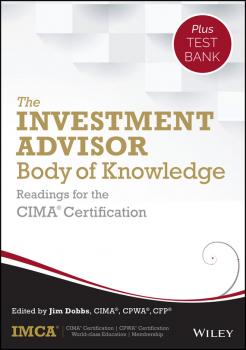ТОП просматриваемых книг сайта:
Управление, подбор персонала
Различные книги в жанре Управление, подбор персонала, доступные для чтения и скачиванияFinancial Forecasting, Analysis and Modelling. A Framework for Long-Term Forecasting - Michael Samonas
Аннотация
Risk analysis has become critical to modern financial planning Financial Forecasting, Analysis and Modelling provides a complete framework of long-term financial forecasts in a practical and accessible way, helping finance professionals include uncertainty in their planning and budgeting process. With thorough coverage of financial statement simulation models and clear, concise implementation instruction, this book guides readers step-by-step through the entire projection plan development process. Readers learn the tools, techniques, and special considerations that increase accuracy and smooth the workflow, and develop a more robust analysis process that improves financial strategy. The companion website provides a complete operational model that can be customised to develop financial projections or a range of other key financial measures, giving readers an immediately-applicable tool to facilitate effective decision-making. In the aftermath of the recent financial crisis, the need for experienced financial modelling professionals has steadily increased as organisations rush to adjust to economic volatility and uncertainty. This book provides the deeper level of understanding needed to develop stronger financial planning, with techniques tailored to real-life situations. Develop long-term projection plans using Excel Use appropriate models to develop a more proactive strategy Apply risk and uncertainty projections more accurately Master the Excel Scenario Manager, Sensitivity Analysis, Monte Carlo Simulation, and more Risk plays a larger role in financial planning than ever before, and possible outcomes must be measured before decisions are made. Uncertainty has become a critical component in financial planning, and accuracy demands it be used appropriately. With special focus on uncertainty in modelling and planning, Financial Forecasting, Analysis and Modelling is a comprehensive guide to the mechanics of modern finance.
Аннотация
Key decisions determine the success of big data strategy Dynamic Customer Strategy: Big Profits from Big Data is a comprehensive guide to exploiting big data for both business-to-consumer and business-to-business marketing. This complete guide provides a process for rigorous decision making in navigating the data-driven industry shift, informing marketing practice, and aiding businesses in early adoption. Using data from a five-year study to illustrate important concepts and scenarios along the way, the author speaks directly to marketing and operations professionals who may not necessarily be big data savvy. With expert insight and clear analysis, the book helps eliminate paralysis-by-analysis and optimize decision making for marketing performance. Nearly seventy-five percent of marketers plan to adopt a big data analytics solution within two years, but many are likely to fail. Despite intensive planning, generous spending, and the best intentions, these initiatives will not succeed without a manager at the helm who is capable of handling the nuances of big data projects. This requires a new way of marketing, and a new approach to data. It means applying new models and metrics to brand new consumer behaviors. Dynamic Customer Strategy clarifies the situation, and highlights the key decisions that have the greatest impact on a company's big data plan. Topics include: Applying the elements of Dynamic Customer Strategy Acquiring, mining, and analyzing data Metrics and models for big data utilization Shifting perspective from model to customer Big data is a tremendous opportunity for marketers and may just be the only factor that will allow marketers to keep pace with the changing consumer and thus keep brands relevant at a time of unprecedented choice. But like any tool, it must be wielded with skill and precision. Dynamic Customer Strategy: Big Profits from Big Data helps marketers shape a strategy that works.
Аннотация
Go inside the trend that spawned a multi-billion dollar industry for the top five percent Sweat Equity goes inside the multibillion dollar trend toward endurance sports and fitness to discover who's driving it, who's paying for it, and who's profiting. Bloomberg's Jason Kelly, author of The New Tycoons, profiles the participants, entrepreneurs, and investors at the center of this movement, exploring this phenomenon in which a surge of people—led by the most affluent—are becoming increasingly obsessed with looking and feeling better. Through in-depth looks inside companies and events from New York Road Runners to Tough Mudder and Ironman, Kelly profiles the companies and people aiming to meet the demands of these consumers, and the traits and strategies that made them so successful. In a modern world filled with anxiety, pressure, and competition, people are spending more time and money than ever before to soothe their minds and tone their bodies, sometimes pushing themselves to the most extreme limits. Even as obesity rates hit an all-time high, the most financially successful among us are collectively spending billions each year on apparel, gear, and entry fees. Sweat Equity charts the rise of the movement, through the eyes of competitors and the companies that serve them. Through conversations with businesspeople, many driven by their own fitness obsessions, and first-hand accounts of the sports themselves, Kelly delves into how the movement is taking shape. Understand the social science, physics, and economics of our desire to pursue activities like endurance sports and yoga Get to know the endurance business's target demographics Learn how distance running—once a fringe hobby—became a multibillion dollar enterprise fueled by private equity Understand how different generations pursue fitness and how fast-growing companies sell to them The opportunity to run, swim, and crawl in the mud is resonating with more and more of us, as sports once considered extreme become mainstream. As Baby Boomers seek to stay fit and Millennials search for meaning in a hyperconnected world, the demand for the race bib is outstripping supply, even as the cost to participate escalates. Sweat Equity, through the stories of men and women inside the most influential races and companies, goes to the heart of the movement where mind, body, and big money collide.
Аннотация
The complete body of knowledge for CIMA candidates and professionals The 2015 Certified Investment Management Analyst Body of Knowledge + Test Bank will help any financial advisor prepare for and pass the CIMA exam, and includes key information and preparation for those preparing to take the test. CIMA professionals integrate a complex body of investment knowledge, ethically contributing to prudent investment decisions by providing objective advice and guidance to individual and institutional investors. The CIMA certification program is the only credential designed specifically for financial professionals who want to attain a level of competency as an advanced investment consultant. Having the CIMA designation has led to more satisfied careers, better compensation, and management of more assets for higher-net-worth clients than other advisors. The book is laid out based on the six domains covered on the exam: I. Governance II. Fundamentals (statistics, finance, economics) III. Portfolio Performance and Risk Measurements IV. Traditional and Alternative Investments V. Portfolio Theory and Behavioral Finance VI. Investment Consulting Process
Аннотация
Winner of the 2017 Most Promising New Textbook Award by Textbook & Academic Authors Association (TAA)! Practical guide to implementing Enterprise Risk Management processes and procedures in government organizations Enterprise Risk Management: A Guide for Government Professionals is a practical guide to all aspects of risk management in government organizations at the federal, state, and local levels. Written by Dr. Karen Hardy, one of the leading ERM practitioners in the Federal government, the book features a no-nonsense approach to establishing and sustaining a formalized risk management approach, aligned with the ISO 31000 risk management framework. International Organization for Standardization guidelines are explored and clarified, and case studies illustrate their real-world application and implementation in US government agencies. Tools, including a sample 90-day action plan, sample risk management policy, and a comprehensive implementation checklist allow readers to immediately begin applying the information presented. The book also includes results of Hardy's ERM Core Competency Survey for the Public Sector; which offers an original in-depth analysis of the Core Competency Skills recommended by federal, state and local government risk professionals. It also provides a side-by-side comparison of how federal government risk professionals view ERM versus their state and local government counterparts. Enterprise Risk Management provides actionable guidance toward creating a solid risk management plan for agencies at any risk level. The book begins with a basic overview of risk management, and then delves into government-specific topics including: U.S. Federal Government Policy on Risk Management Federal Manager's Financial Integrity Act GAO Standards for internal control Government Performance Results Modernization Act The book also provides a comparative analysis of ERM frameworks and standards, and applies rank-specific advice to employees including Budget Analysts, Program Analysts, Management Analysts, and more. The demand for effective risk management specialists is growing as quickly as the risk potential. Government employees looking to implement a formalized risk management approach or in need of increasing their general understanding of this subject matter will find Enterprise Risk Management a strategically advantageous starting point.
Central Counterparties. Mandatory Central Clearing and Initial Margin Requirements for OTC Derivatives - Jon Gregory
Аннотация
Practical guidance toward handling the latest changes to the OTC derivatives market Central Counterparties is a practical guide to central clearing and bilateral margin requirements, from one of the industry's most influential credit practitioners. With up-to-date information on the latest regulations imposed after the global financial crisis, this book covers the mechanics of the clearing process and analyses the resulting consequences. Detailed discussion explains the ways in which the very significant clearing and margining rules will affect the OTC derivatives market and the financial markets in general, with practical guidance toward implementation and how to handle the potential consequences. Over-the-counter derivatives were blamed by many for playing a major role in the 2007 financial crisis, resulting in a significant attention and dramatic action by policymakers, politicians, and regulators to reduce counterparty credit risk which was seen as a major issue in the crisis. The two most important regulatory changes are the mandatory clearing of standardised OTC derivatives, and the requirements for bilateral margin posting in non-standard OTC contracts. Central Counterparties is a complete reference guide to navigating these changes, providing clarification and practical advice. Review the mitigation of counterparty credit risk with the historical development of central clearing Clarify the latest regulatory requirements imposed by Dodd-Frank, EMIR, Basel III and more Learn the mechanics of central clearing, with special attention to complex issues such as margin calculations, the loss waterfall, client clearing and regulatory capital rules Gain insight into the advantages and disadvantages of clearing and bilateral margin requirements, and the potential issues that arise As the clearing and margining mandates are phased in, the associated costs will be severe enough to dramatically shift the topology of the financial markets and transform the nature of risk. Central Counterparties provides the information, clarification and expert insight market practitioners need to get up to speed quickly.
Аннотация
Get insider details on how to operate a successful bar Running a Bar For Dummies, 2nd Edition shows established and future bar owners how to establish and maintain a successful business. Using clear, concise language, this For Dummies guide contains all the information you need to start your bar off on the right foot. From grand opening to last call, you'll discover the insider tricks that keep the business end running smoothly and the customers happily engaged. With updated information on marketing and social media, the book walks you step by step through the entire process, revealing the nitty-gritty details most new bar owners only discover after starting. The bar business continues to grow; however, securing running capital and having knowledge about the business are cited as the two biggest reasons new bars fail. Running a Bar For Dummies, 2nd Edition shines a light on these issues to help bar owners prepare properly. The book helps you find your way through the maze of licensing and permits, developing a business plan, and preparing for your grand opening, plus offers clear, no-nonsense guidance on dealing with tough customers. Every step of the way, Running a Bar For Dummies, 2nd Edition is a reference you can count on. Understand the bar business and important legal issues Stock the necessities, including equipment and inventory Promote your business using marketing and social media Manage expenses and control cash flow When run correctly, a bar can be an extremely profitable business, but the key to success is knowing exactly what you're getting into. By recognizing common problems and teach you how to adapt quickly to changing conditions, Running a Bar For Dummies, 2nd Edition provides the information you need to develop those skills, and get your bar started.
Emerging Markets in an Upside Down World. Challenging Perceptions in Asset Allocation and Investment - Jerome Booth
Аннотация
The world is upside down. The emerging market countries are more important than many investors realise. They have been catching up with the West over the past few decades. Greater market freedom has spread since the end of the Cold War, and with it institutional changes which have further assisted emerging economies in becoming more productive, flexible, and resilient. The Western financial crisis from 2008 has quickened the pace of the relative rise of emerging markets – their relative economic power, and with it political power, but also their financial power as savers, investors and creditors. Emerging Markets in an Upside Down World – Challenging Perceptions in Asset Allocation and Investment argues that finance theory has misunderstood risk and that this has led to poor investment decisions; and that emerging markets constitute a good example of why traditional finance theory is faulty. The book accurately describes the complex and changing global environment currently facing the investor and asset allocator. It raises many questions often bypassed because of the use of simplifying assumptions and models. The narrative builds towards a checklist of issues and questions for the asset allocator and investor and then to a discussion of a variety of regulatory and policy issues. Aimed at institutional and retail investors as well as economics, finance, business and international relations students, Emerging Markets in an Upside Down World covers many complex ideas, but is written to be accessible to the non-expert.
Аннотация
Praise for Financial Markets, Banking, and Monetary Policy “A lucid treatment that takes on board shadow-banking, Dodd-Frank, the zero lower bound, and forward guidance. In short, all the key post-crisis issues.” —Anil Kashyap, Edward Eagle Brown Professor of Economics and Finance, University of Chicago “The financial sector is a vital component of the US economic machinery. The Federal Reserve works within this sector to promote its congressional mandates of maximum employment and low inflation. Unfortunately, the contribution of the financial system to the economy’s performance is not well understood. Students of standard college courses on money, banking, and monetary policy often find that the textbooks have not kept pace with the evolution of the financial sector, including the rise of securitized finance and the Federal Reserve’s evolving monetary operations. Tom Simpson’s book represents a huge step forward in this regard. His comprehensive exposition of the essential parts of the financial system and modern explanation of how the Federal Reserve supports the economy gives readers a much better understanding of the US financial system and the Federal Reserve.” —James Glassman, Managing Director and Head Economist for the Commercial Bank, JPMorgan Chase & Co. “Financial Markets, Banking, and Monetary Policy by Tom Simpson provides a comprehensive introduction to the financial system, including the markets, institutions, and mechanisms of finance, as well as the role of the Federal Reserve and monetary policy. The economic principles underlying finance are woven through the chapters, and the book includes an insightful introduction into the causes of and responses to the recent financial crisis. Tom Simpson has had a front-row seat on financial developments in recent decades and has written a book that provides an ideal introduction to the financial system and monetary policy.” —Dan Sichel, Professor of Economics, Wellesley College
Аннотация
Proven leadership strategies that will impact your career and your company Having the right CFO is a critical component for every company's success. Guide to CFO Success provides CFOs and those in the making with a strategic blueprint to benefit their companies and their careers. This book reveals how to build a strong, successful career plan with guidance on team building and management of the multiple relationships that CFOs face on a daily basis, plus how to balance one's work and personal life. Offers strategic guidance for leadership growth for CFOs Presents essential information for every CFO who wants to play a tactical role in their organization Includes best practices for building and developing the most effective Finance Team Features practical career advice for future Chief Financial Officers From balancing one's work and personal life to dealing with the CEO, Guide to CFO Success has the answers you need to plan for a strong and successful career.










